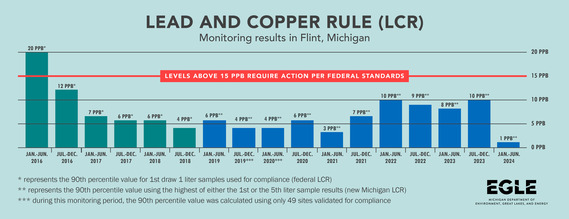|
FOR IMMEDIATE RELEASE
August 2, 2024
EGLE Media Office, [email protected], 517-284-9278
Lead levels in Flint decline in latest round of water testing
Eighth year of compliance with strict state standards demonstrates success of water infrastructure improvements
The Michigan Department of Environment, Great Lakes, and Energy (EGLE) today announced that the City of Flint?s Lead and Copper Rule (LCR) monitoring has shown the 90th percentile for lead to be 1 part per billion (ppb). This result marks the eighth consecutive year the city?s water has met the requirements of the Safe Drinking Water Act.
Since July 2016, the city of Flint?s water system has tested below action levels for both lead and copper during 17 consecutive monitoring periods. The latest six-month monitoring period from Jan. 1, 2024, through June 30, 2024, resulted in a 90th percentile calculation for the samples collected of 1 ppb for lead. This includes Michigan?s stricter-than-federal requirement that a fifth liter sample be collected to better reflect the impact of lead service lines. ?
The 90th percentile calculation of 1 ppb means 90 percent of the sampling results used in the calculation came in at or below 1 ppb. This result represents a significant drop in comparison to the previous six-month monitoring period which had a 90th percentile of 10 ppb.?
Of the 64 sample results included in the calculation, only two were above 3 ppb. The highest result was 13 ppb.
?This dramatic drop in lead detections demonstrates the effectiveness of the corrosion control treatment in the city?s modernized water infrastructure,? said Eric Oswald, director of EGLE?s Drinking Water and Environmental Health Division. ?Another reason for the significant decline in this testing period is the absence of Tier 2 (non-residential) sites in the compliance monitoring. We may never see zero detections of lead due to the presence of in-home lead plumbing and other factors such as low water usage leading to stagnation in non-residential properties, but this latest round of testing gives us confidence that Flint residents? drinking water is consistently meeting the requirements of the Safe Drinking Water Act.?
The increase in Tier 1 (residential) sites in this monitoring period was due to work done in the fall of 2023 by the City of Flint to positively identify suspected lead service lines prior to the deadline for a complete distribution system materials inventory from every water system in the state by October 16, 2024.
Adopted in 2018, the Michigan LCR requires that all lead service lines in the state be removed at the expense of the water supply and requires replacement of an average of five percent of lead service lines annually over a 20-year period that started in 2021. Starting in 2025, the rule lowers the action level to 12 ppb.
Flint?s testing results can be found by visiting the State?s Flint Water website. Additional information about Michigan?s new testing requirements and results state-wide can be found at Mi Lead Safe.
 ###
|